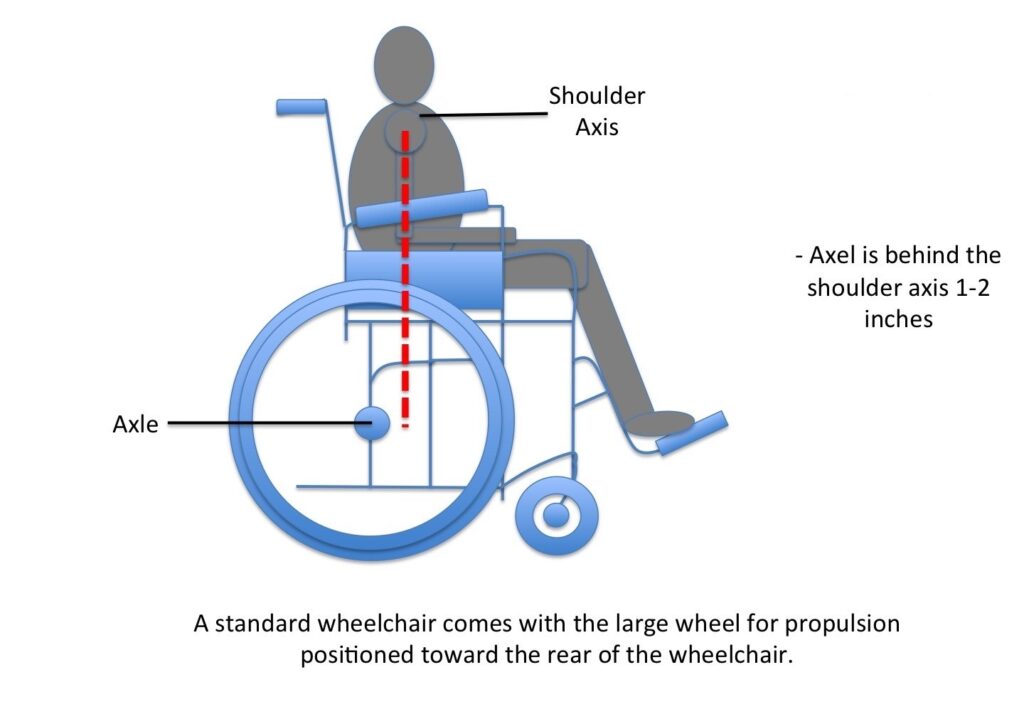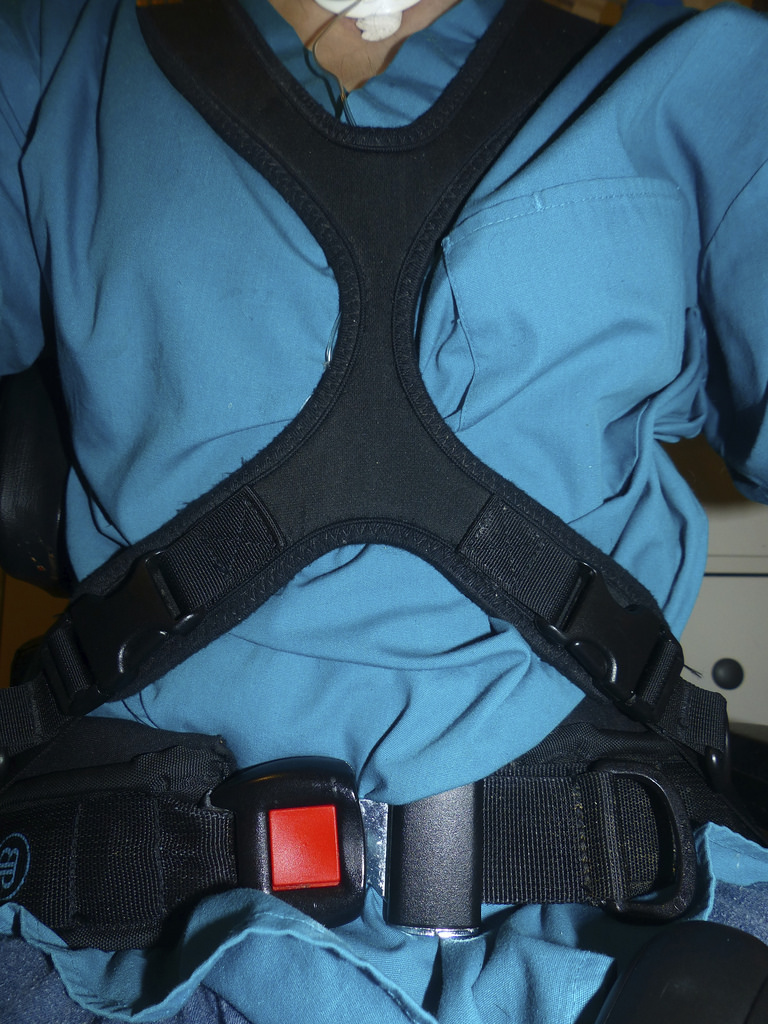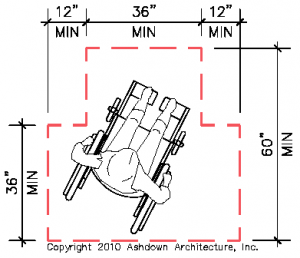Standard Wheelchair

The following charts will review types of wheelchairs, the parts of a wheelchair, and various assistive technology items that people who use wheelchairs utilize.
Types of Wheelchairs
| Type | Description | How it is used | Who would use it – diagnoses | Examples | Videos and Photos |
| Power wheelchair
|
A wheelchair that operates electronically using a battery and electric controls | The person uses a power control customized to their abilities to maneuver the wheelchair.
-joystick |
Diagnoses that result in the person being too weak to propel a manual chair, yet having enough motor control to operate the power controls
-spinal cord injury, any level |
A woman with advanced multiple sclerosis uses a power wheelchair with a knob style hand control to maneuver her power wheelchair through a shopping mall. |
|
| Manual wheelchair
|
A wheelchair that is propelled without the use of electricity | The person pushes the wheelchair with their hands, feet or both. Another person may also push the wheelchair as the person rides.
-Wheelchair brakes should be locked before the person transfers into or out of the wheelchair. This detail is very important for the patient’s safety and should always be taught first when educating a patient to use a wheelchair. |
Diagnoses where the person has enough upper body strength to push the wheelchair:
-spinal cord injury, mid-thoracic, lumbar, sacral -severe quadriplegic cerebral palsy |
A man with an L1-L2 spinal cord injury uses a manual racing wheelchair to compete in a Paralympic race. | |
| Lightweight wheelchair
|
A wheelchair that is made with lighter materials and designed to fold for travel. | The person transfers into the mode of transportation, then folds the wheel-chair and lifts it into the storage compartment or asks someone else to fold and store the wheelchair. | Diagnoses that allow the person to drive and/or travel frequently.
-spinal cord injury |
A man with a T9-T10 spinal cord injury folds and lifts his lightweight wheelchair into the back seat of his car after transferring to the driver’s seat. |
|
| Standing wheelchair
|
A power wheelchair that uses hydraulics to lift the person to a standing position and support the person in standing. | The person uses the power controls to change the wheelchair from sitting to standing position. | Diagnoses that prevent the person from standing without total support.
-cerebral palsy |
A woman with muscular dystrophy uses a standing wheelchair to stand and reach her kitchen cupboards so she can put away lightweight dishes. |
|
Wheelchairs are fit to people by taking measurements at certain body landmarks. A person who requires a wheelchair usually undergoes a complete wheelchair assessment.
This link provides an example of a wheelchair assessment form.
| Measurement | Description |
| Seat width
|
Measure the widest point across the hips and thighs and then add 2 inches. |
| Seat depth
|
Measure from the posterior portion of the buttocks to the popliteal fossa and then subtract 2 inches. Measure both legs and take the greatest length. |
| Back height | Measure from the seat surface (including the cushion) upward to one of the following, depending on trunk control, activity level, strength and size of the person: 1. Mid back to 1-2 inches below the scapula. 2. Mid scapula or axilla. 3. Top of the shoulder. |
| Seat height | Footrests should have 2 inches of clearance from the floor.
Standard height = 19″- 20″ |
| Armrest height | Shoulders should be neutral with arms hanging at the sides and elbows flexed to 90 degrees.
–Armrests that are too low will encourage leaning forward. |
| Chair Style | Seat Width | Seat Depth | Seat Height |
| Standard Adult | 18″ | 16″ | 19.5″ |
| Narrow Adult | 16″ | 16″ | 19.5″ |
| Slim Adult | 14″ | 16″ | 19.5″ |
| Wide Width Adult | 20″ | 16″ | 19.5″ |
| Junior | 16″ | 16″ | 18.5″ |
| Child | 14″ | 11.5″ | 18.76″ |
| Tiny Tot | 12″ | 11.5″ | 19.5″ |
Wheelchair Attachments
| Device | Description | How it is used | Who would use it – diagnoses | Examples | Photo/Video |
| Pelvic support strap; chest harness | Straps and harnesses are strategically mounted to the seat of the wheelchair. | The straps are placed to support the pelvis and adjust alignment, depending on the person’s condition. A chest harness is placed to support the upper trunk. | -spinal cord injury, any level -cerebral palsy -Alzheimer’s disease -multiple sclerosis -traumatic brain injury -CVA -multiple sclerosis -muscular dystrophy, advanced |
A man with Alzheimer’s disease uses pelvic support straps to prevent his pelvis from sliding forward in his wheelchair, resulting in posterior pelvic tilt and potential for pressure sores. |  |
| Wheelchair tray | A tray placed across the armrests of a wheelchair. The tray usually slides onto the armrest pads and is positioned even with the upper abdomen of the person. | Used as a flat work surface for the person. Trays may be used for meals, work tasks, self care tasks, and carrying objects from place to place. | -CVA -cerebral palsy -congenital conditions -Alzheimer’s disease -multiple sclerosis -muscular dystrophy -spinal cord injury, mid-cervical and below |
A teenager with spastic quadriplegia cerebral palsy uses his wheelchair tray to hold a switch array so that he can operate kitchen appliances during a cooking class. | |
| Lateral supports |
Firm, padded projections mounted to the sides of the wheelchair back, or curved sides built in to the back of a wheelchair. | The projections are positioned to support the sides of the person’s trunk to prevent lateral leaning. | -severe kyphosis -severe scoliosis -post CVA -cerebral palsy -multiple sclerosis -cervical or thoracic spinal cord injury |
An elderly woman with severe kyphosis is able to sit in forward alignment in her wheelchair with a lateral support in place to compensate for her tendency to lean to the left. | |
| Posey drop seat cushion |
A cushion with a pommel in the front middle. | The cushion is used in a wheelchair with a lowered seat (drop seat). The person sits on the cushion with the pommel between his or her legs to prevent the hips from adducting or the legs from crossing. | -spinal cord injury C1-L1 -spastic cerebral palsy -advanced Alzheimer’s disease -severe traumatic brain injury -severe seizure disorder -hip fracture |
A man with Alzheimer’s disease who has fractured his hip sits on a Posey drop seat cushion in his wheelchair to keep his hips in alignment while he heals. |  |
| Foot/ankle straps | Straps attached at the front or back of the footrests. | Straps are used to position the feet on the footrests. They may be used to hold the feet on the footrests if the patient is unable to hold the feet in place independently. Foot and ankle straps that are used to position the feet when the patient is unable to do so are not considered restraints. | -CVA -traumatic brain injury -multiple sclerosis and other neurological conditions -cerebral palsy -seizure disorder -lower extremity contractures |
A young man with quadriplegic cerebral palsy uses ankle straps to position his feet on the footrests of his wheelchair, as he cannot position his feet himself due to high lower extremity extensor tone. |  |
| Arm trough | A trough that mounts on the wheelchair armrest. The trough may have an elevated insert. | The trough is used to position a flaccid upper extremity. Edema can be reduced or prevented with use of the elevated insert. | CVA with upper extremity hemiparesis | A woman who has suffered a CVA and has right hemiparesis is admitted to a nursing home and is positioned in her wheelchair with her right arm elevated on an arm trough to prevent edema. | |
| Mobile arm support |
A movable arm trough, that supports the forearm. | This device is used to allow horizontal movement of a paralyzed arm. A hinge on the support allows vertical movement by moving the shoulder to flex and extend the elbow. Some scapular movement must be present for a mobile arm support to be functional. | C4 to C7 spinal cord injury, advanced multiple sclerosis, advanced muscular dystrophy, ALS | A man with a C5 spinal cord injury uses a mobile arm support along with a universal cuff to type on a computer keyboard. | |
| All terrain wheelchair wheels |
Wheelchair tires with special treads, power wheelchairs with tracks instead of wheels | Allow the person to propel the wheelchair on uneven surfaces. | Any diagnosis that requires wheelchair use. | A man with severe arthritis uses an all terrain wheelchair while hunting. | |
| Hill-holder device | A device that allows a wheelchair to move forward but automatically brakes when the wheelchair rolls backward. | Allows the person to propel the wheelchair up ramps and hills without rolling backward. | Generalized weakness, rheumatoid arthritis, cerebral palsy, spinal cord injury, multiple sclerosis. | A woman with multiple sclerosis is able to use her hands to propel her wheelchair but uses a hill-holder device to prevent her chair from rolling backwards as she pushed herself up the ramp at work. |
Certain diagnoses have specific wheelchair adaptations that have been proven to work well. The following chart reviews a few of these protocols:
| Diagnosis | Adaptations | Rationale | Example | Video |
| Hip replacement | Reclining back, pommel cushion or hip abductor, pelvic positioning strap, elevating footrests. | After hip replacement surgery, the patient is not allowed to bend the affected hip past 90 degrees or to adduct the hip. The reclining back allows the patient to sit with the hip positioned at less than 90 degrees of flexion and the pommel cushion keeps the hip positioned in slight abduction. The pelvic strap prevents the patient from sliding forward in the chair and the elevating footrests help to control edema post surgery | A woman who is one week post hip replacement surgery sits up in a wheelchair with the back reclined 10 degrees to allow her to eat lunch in the rehabilitation center dining room. | |
| Spinal cord injury | Contoured solid seat and back inserts, pelvic and lower extremity positioning straps, lateral supports, chest support, lateral head support, may need power wheelchair, may need adapted switches to operate a power wheelchair. May use a standing wheelchair. | The solid seat and back are contoured to improve support and reduce the risk of pressure areas. The positioning straps hold the pelvis and lower extremities in place in the chair. If the person has a cervical or high thoracic injury, a chest support and lateral supports keep the trunk aligned and prevent the person from slumping forward. For high cervical injuries, a lateral head support keeps the head and neck in midline. | A man with a C5 spinal cord injury uses a head activated switch mounted to his lateral head support to propel his power wheelchair. | |
| Spina bifida | Manual or power wheelchair with an adapted back, pressure relief cushions. | Children with spina bifida may need a custom back on a wheelchair to accommodate myelomeningocele (the portion of the spinal cord that protrudes from the spinal column). Pressure relief cushions are used to reduce risk of skin breakdown in areas with reduced sensation. | A boy with spina bifida uses a power wheelchair with a custom back and ROHO style cushion to get around his school. | |
| Cerebrovascular accident (CVA) | Hemi-wheelchair with one arm drive, solid seat with gel for pressure relief, elevated armrest. | The hemi-wheelchair is a lower height wheelchair that allows the person to propel the chair with the unaffected foot. A one arm drive allows the person to propel the wheelchair with the unaffected hand while keeping the wheelchair moving in a straight line. Gel or memory foam in the cushion helps to reduce the risk of pressure areas on the affected side. The elevated arm rest helps reduce edema in the affected arm. | A woman who has had a CVA propels her wheelchair around the rehabilitation facility, using her unaffected foot and hand to propel a hemi-wheelchair with one arm drive. |
‘
Maneuvering Space
Maneuvering space is defined as the space required for a wheelchair to make a 180-degree turn.
The Americans With Disabilities Act stipulates providing a minimum turning radius of 60-inch (1525 mm) for a standard wheelchair. This should be considered when renovating a home to be wheelchair accessible.

…. ……..